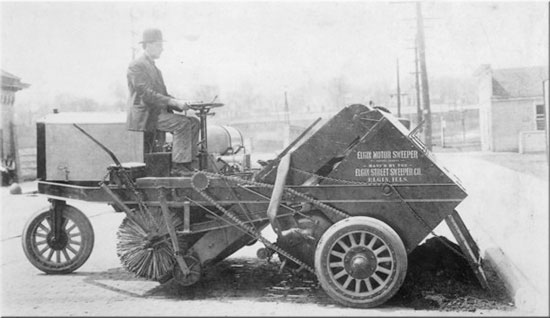Fleet Management Information for Sweeping Professionals |
Winter Ready: Essential Tips for Preparing Your Street Sweepersprovided by Elgin Sweeper Company It's crucial for municipalities and contractors to winterize their street sweepers to withstand harsh weather. Effective winterization helps ensure that sweepers stay operational and in peak condition, minimizing downtime and costly repairs.


Elgin Sweeper, a leader in street sweeper manufacturing with over a century of expertise, produces sweepers for general maintenance, industrial sites, and airports. Drawing from their extensive experience, Elgin Sweeper shares best practices for winterizing street sweepers to maintain functionality and longevity through winter's challenging conditions. 1. Thorough Cleaning and InspectionBefore temperatures plunge, give your street sweeper a deep clean. Clear out all debris from the hopper, brushes, and other areas that collect dirt. This is also a prime opportunity to inspect the sweeper for any signs of damage, including cracks, rust, or worn parts. Identifying and addressing these issues early helps avoid more serious and expensive repairs when freezing conditions set in. 2. Drain and Prepare Water SystemsWater systems are particularly susceptible to freezing, which can cause damage. For sweepers in storage, completely drain all water tanks, hoses, and pumps to prevent ice buildup. For sweepers in active use during winter, add a non-toxic antifreeze solution to the water system to prevent freezing. This is especially critical for sweepers that rely on water for dust control. 3. Battery MaintenanceBattery performance can drop in cold weather, so it's wise to store both the sweeper and its battery in a temperature-controlled environment when not in use. Fully charge the high-voltage battery before long-term storage to maintain optimal battery health and ensure readiness when the sweeper is back in operation. 4. Protect the Fuel SystemCold weather can lead to condensation in fuel tanks, which risks contaminating the fuel. To reduce this risk, keep the fuel tank full to limit air exposure. Adding a fuel stabilizer also helps prevent fuel degradation. For long-term storage, consider draining the fuel system entirely to avoid complications. 5. Inspect and Refresh Lubricants and FluidsCold temperatures can cause lubricants to thicken, reducing their efficiency. Be sure to check all fluid levels, including engine oil, hydraulic fluid, and coolant, and replace any fluids that need refreshing. For optimal performance, use winter-grade lubricants, and lubricate all moving parts to prevent stiffness or wear in low temperatures. 6. Shield Metal Surfaces from CorrosionWinter weather can accelerate corrosion on metal components. Applying a corrosion inhibitor or grease to exposed metal surfaces helps prevent rust and structural damage. Pay special attention to moisture-prone areas, like joints and hinges, to maintain the sweeper's durability and performance. 7. Maintain Brushes and BroomsInspect the sweeper's brushes and brooms for signs of wear. Replace any worn or damaged parts to ensure effective sweeping. Consider adjusting broom settings to handle debris commonly found in winter, such as sand and salt. 8. Extra Measures for Long-Term StorageFor sweepers stored over extended periods, take extra steps to protect them. Keep the sweeper in a dry, covered area, shielded from weather exposure. Cover it with a tarp or similar protection to prevent moisture buildup, and ensure all drains remain open so that any remaining water can escape. By following these winterization steps, municipalities and contractors can keep their sweepers running smoothly and avoid seasonal breakdowns. Proper winter preparation extends equipment lifespan, supporting public safety by ensuring cleaner, safer streets in the toughest winter weather. To learn more about Elgin Sweeper and best practices for sweeper maintenance and more, visit ElginSweeper.com. If you have questions or comments about this information, please, let us know. If appropriate, we can add it in as an addendum to this article. |
© 2005 - 2024 World Sweeper
|
Back to Fleet Management InformationSite Map / Table of Contents |